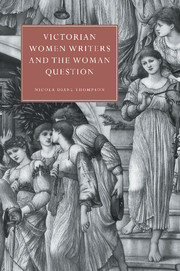Book contents
- Frontmatter
- Contents
- List of illustrations
- Notes on contributors
- 1 Responding to the woman questions: rereading noncanonical Victorian women novelists
- 2 Marriage and the antifeminist woman novelist
- 3 Breaking apart: the early Victorian divorce novel
- 4 Phantasies of matriarchy in Victorian children's literature
- 5 Gendered observations: Harriet Martineau and the woman question
- 6 Maximizing Oliphant: begging the question and the politics of satire
- 7 Literary women of the 1850s and Charlotte Mary Yonge's
- 8 Portraits of the artist as a young woman: representations of the female artist in the New Woman fiction of the 1890s
- 9 Lady in green with novel: the gendered economics of the visual arts and mid-Victorian women's writing
- 10 Ouida and the other New Woman
- 11 Organizing women: New Woman writers, New Woman readers, and suffrage feminism
- 12 Shot out of the canon: Mary Ward and the claims of conflicting feminism
- 13 E. Nesbit and the woman question
- 14 “An ‘old-fashioned’ young woman”: Marie Corelli and the New Woman
- CAMBRIDGE STUDIES IN NINETEENTH-CENTURY LITERATURE AND CULTURE
11 - Organizing women: New Woman writers, New Woman readers, and suffrage feminism
Published online by Cambridge University Press: 01 March 2010
- Frontmatter
- Contents
- List of illustrations
- Notes on contributors
- 1 Responding to the woman questions: rereading noncanonical Victorian women novelists
- 2 Marriage and the antifeminist woman novelist
- 3 Breaking apart: the early Victorian divorce novel
- 4 Phantasies of matriarchy in Victorian children's literature
- 5 Gendered observations: Harriet Martineau and the woman question
- 6 Maximizing Oliphant: begging the question and the politics of satire
- 7 Literary women of the 1850s and Charlotte Mary Yonge's
- 8 Portraits of the artist as a young woman: representations of the female artist in the New Woman fiction of the 1890s
- 9 Lady in green with novel: the gendered economics of the visual arts and mid-Victorian women's writing
- 10 Ouida and the other New Woman
- 11 Organizing women: New Woman writers, New Woman readers, and suffrage feminism
- 12 Shot out of the canon: Mary Ward and the claims of conflicting feminism
- 13 E. Nesbit and the woman question
- 14 “An ‘old-fashioned’ young woman”: Marie Corelli and the New Woman
- CAMBRIDGE STUDIES IN NINETEENTH-CENTURY LITERATURE AND CULTURE
Summary
I once asked a lady, who knew Thackeray intimately, whether he had any model for Becky Sharp. She told me that Becky was an invention, but that the idea of the character had been partly suggested by a governess who lived in the neighborhood of Kensington Square, and was the companion of a very selfish and rich old woman. I inquired what became of the governess, and she replied that, oddly enough, some years after the appearance of Vanity Fair, she ran away with the nephew of the lady with whom she was living, and for a short time made a great splash in society, quite in Mrs. Rawdon Crawley's style, and entirely by Mrs. Rawdon Crawley's methods. Ultimately she came to grief, disappeared to the Continent, and used to be occasionally seen at Monte Carlo and other gambling places.
Oscar Wilde, “The Decay of Lying” (1889)In “The Decay of Lying,” Oscar Wilde caricatures the woman reader by noting how she cannot distinguish between fiction and reality: reading about Thackeray's Becky Sharp, she seeks to become Becky Sharp. Like the “silly boys” who read the “adventures of Jack Sheppard and Dick Turpin” and “pillage the stalls of unfortunate apple-women, break into sweet-shops at night, and alarm old gentlemen returning home from the city by leaping out on them in suburban lanes, with black masks and unloaded revolvers,” the woman reader epitomizes “life's imitative instinct,” its unimaginative literalization of art's creativity. Published in 1889, Wilde's witticism both glosses and glances away from the issues this chapter will address.
- Type
- Chapter
- Information
- Victorian Women Writers and the Woman Question , pp. 189 - 203Publisher: Cambridge University PressPrint publication year: 1999
- 2
- Cited by

